Table of Contents
Quality Service Guarantee Or Painting Free

Get a rental agreement with doorstep delivery

Find the BEST deals and get unbelievable DISCOUNTS directly from builders!

5-Star rated painters, premium paints and services at the BEST PRICES!
Loved what you read? Share it with others!
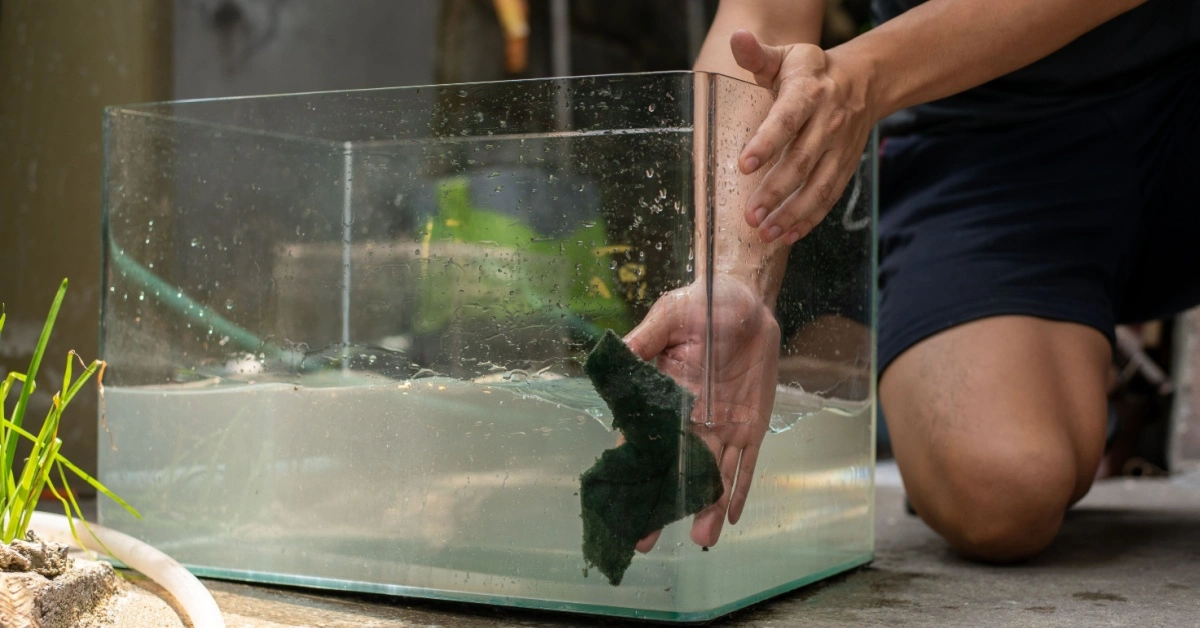

Submit the Form to Unlock the Best Deals Today
Check Your Eligibility Instantly

Experience The NoBrokerHood Difference!
Set up a demo for the entire community

Tenant Super Relax Plan
Enjoy Hassle-Free Renting
 Full RM + FRM support
Full RM + FRM support Instant alerts & premium filters
Instant alerts & premium filters Rent negotiation & relocation help
Rent negotiation & relocation helpSubmit the Form to Unlock the Best Deals Today
How to Clean Your Fish Tank at Home: Simple and Easy Steps to Clean Your Aquarium 2025
Table of Contents
Are you keeping fish but don’t know how to clean fish tanks? A clean fish tank is mandated for keeping your aquatic pets live a long, healthy, and hygienic life. Cleaning a fish tank might seem daunting at first, but it becomes an easy and quick task with a few simple steps and a routine. This guide will walk you through everything you need to know, from gathering supplies to tackling common problems like algae and cloudy water, making your fish tank a beautiful centrepiece in your home.
What You Need to Clean a Fish Tank at Home?
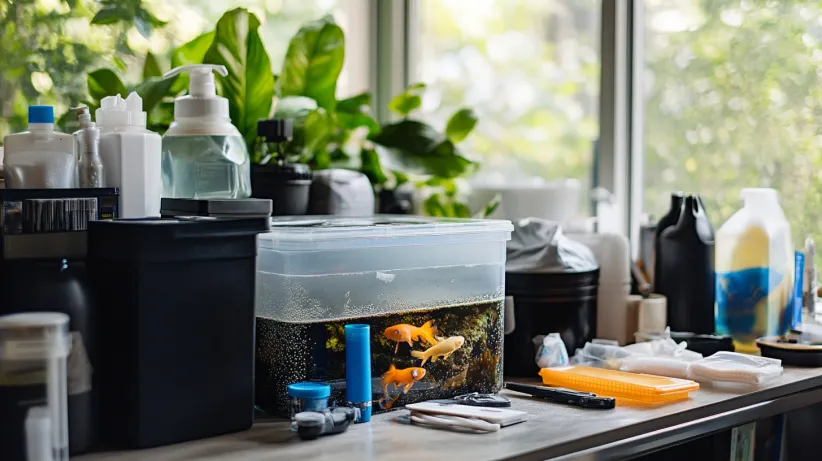
Now that you have learned how to clean a fish tank at home, gather all your supplies to make the process smoother and quicker. Having everything ready means less stress for you and your fish. List of supplies:
- A clean bucket (used ONLY for fish tank cleaning)
- Aquarium water siphon (gravel vacuum)
- Algae scraper or pad (choose one appropriate for your tank material - acrylic or glass)
- Clean towels or paper towels
- Fish-safe water conditioner (dechlorinator)
- Clean toothbrush (new, used ONLY for fish tank decor)
- Replacement filter media (if it's time to change it, as per the manufacturer's instructions)
- Rubber gloves (optional, but suitable for protecting your hands)
- A temporary holding container for fish (optional, only if doing a major clean or if fish are extremely sensitive – generally, it's less stressful to leave them in)
How Do You Clean a Fish Tank Without Stressing the Fish?
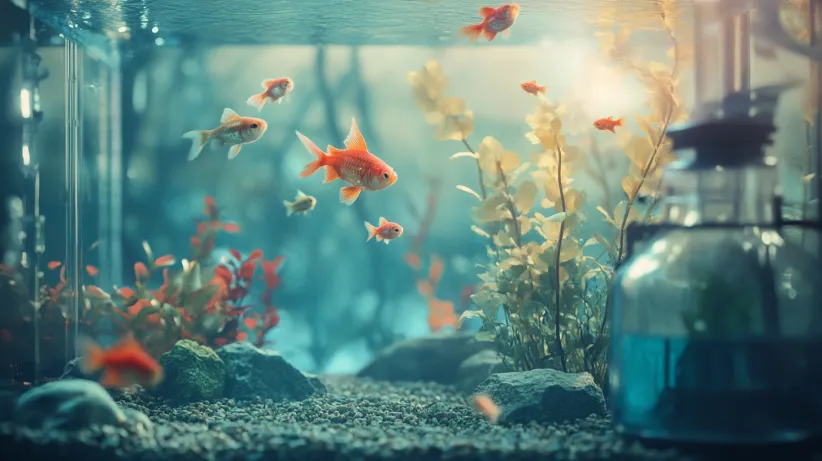
The key to cleaning a fish tank without stressing your fish is to be gentle, quick and avoid drastic changes in their environment. Understanding how to clean a fish tank with minimal disturbance is crucial for their well-being.
Quality Service Guarantee Or Painting Free

Get a rental agreement with doorstep delivery

Find the BEST deals and get unbelievable DISCOUNTS directly from builders!

5-Star rated painters, premium paints and services at the BEST PRICES!
- Step 1: Unplug all tank equipment, such as filters, heaters, and lights. This prevents electric shock and protects devices from damage during cleaning, ensuring safety for you and your fish.
- Step 2: Gently scrub algae off the interior glass using an appropriate scraper or pad. Work from top to bottom, being careful near seals to prevent damage and avoid scratching tank surfaces.
- Step 3: Remove and clean larger decorations using a fish-safe brush and siphoned tank water. Never use soap. Rinse them well with old tank water or fresh, dechlorinated water before returning.
- Step 4: Use a gravel vacuum to clean substrate and remove 20-30% of tank water. Move the siphon through gravel to suck up waste. Avoid pulling over 50% of the water.
- Step 5: Gently rinse filter media (sponges, etc.) in the siphoned tank water collected in your bucket. Avoid tap water to protect beneficial bacteria. Stagger cartridge replacements if applicable.
- Step 6: Fill the tank with dechlorinated tap water that matches its temperature. Pour slowly onto a decoration or glass to minimise substrate disturbance and avoid stressing your fish with sudden changes.
- Step 7: Reconnect all electrical equipment, such as filters and heaters. Double-check that everything is working correctly. Allow a few hours for any temporary cloudiness in the water to settle down.
How to Remove Algae from Fish Tanks the Right Way?
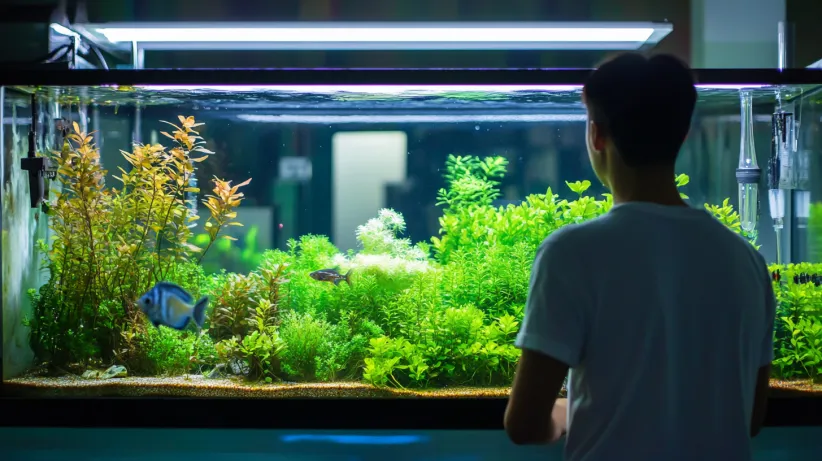
Algae are a typical guest in most aquariums. Knowing how to correctly remove algae from a fish tank involves physical removal and addressing the underlying causes, such as excess light or nutrients.
- Step 1: Use an algae scraper suited for your tank type (plastic blade for acrylic, metal for glass if careful) to scrub algae off the glass. For plants and decorations, a soft brush or your fingers will work. Magnetic algae cleaners are also great for daily touch-ups on the glass.
- Step 2: Use your gravel vacuum during water changes to suck up loose algae particles from the gravel.
- Step 3: Reduce the hours your aquarium light is on (aim for 6-8 hours a day). Avoid direct sunlight on the tank. Don't overfeed your fish, as uneaten food contributes to nutrients that algae thrive on. Regular water changes also help control nutrient levels.
- Step 4: Consider Algae Eaters (with caution). Certain fish (like Otocinclus catfish or Bristlenose plecos) and invertebrates (like Amano shrimp or Nerite snails) can help control algae. Research carefully to ensure they are compatible with your tank size and other inhabitants.
How to Remove Ammonia from a Fish Tank?
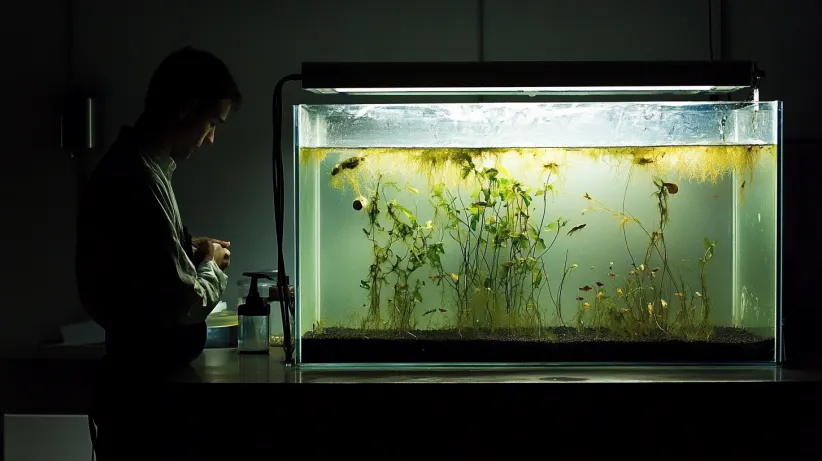
High ammonia levels are toxic to fish and indicate an unhealthy tank. Knowing how to remove ammonia from a fish tank quickly is vital for your fish's survival. Issues with your tank's nitrogen cycle often indicate this.
- Step 1: Using a gravel vacuum, change 25-50% of the tank water. Make sure the new water is dechlorinated and temperature-matched. This immediately dilutes the ammonia concentration.
- Step 2: Use a commercially available ammonia detoxifier or binder. These products can temporarily neutralise ammonia, making it less harmful while you address the root cause. Follow product instructions carefully.
- Step 3: Ammonia spikes can be caused by overfeeding, a dead fish, new tank syndrome (an unestablished nitrogen cycle), or a compromised filter (e.g., cleaning media with tap water). Stop feeding for a day or two, check for and remove any dead inhabitants, and ensure your filter functions correctly with healthy, beneficial bacteria.
- Step 4: Ammonia is more toxic at higher pH and temperature, and less harmful in well-oxygenated water. Adding an air stone can help increase oxygen levels.
- Step 5: Continue testing for ammonia daily and performing water changes as needed until the level drops to zero and stays there. Also, test for nitrite, as this is the next stage in the nitrogen cycle.
How to Clean a Fish Tank with Algae Overgrowth?
Knowing how to clean fish tank with algae requires a little more care.
- Step 1: Scrub all surfaces – glass, substrate, decorations, and equipment. You might need to remove decorations and large hardscape items to clean them thoroughly outside the tank (using old or dechlorinated water).
- Step 2: After scrubbing, a larger water change (around 50%) will help remove the dislodged algae and the excess nutrients it was feeding on. Siphon the substrate thoroughly.
- Step 3: Clean your filter, but do not destroy all beneficial bacteria. Rinse sponges and media in siphoned tank water. If the filter media is clogged with algae, it may need more rigorous cleaning or partial replacement (stagger replacements).
- Step 4: For severe algae blooms (especially green water), a 3-4 day blackout can help. Cover the tank completely to block all light. Ensure good aeration during this period. Do not feed your fish during the blackout.
- Step 5: Algae overgrowth means there's too much light, too many nutrients (from overfeeding or insufficient water changes), or not enough water circulation. Adjust lighting schedules and feeding amounts, and ensure an adequate water change routine. Consider adding live plants, as they compete with algae for nutrients.
Tackling severe algae requires patience and consistent effort to restore balance.
How to Clean Cloudy Fish Tank Water?
Learning to clean cloudy fish tank water depends on identifying the cause, which can be bacterial blooms, stirred-up substrate, or algae.
- Step 1: Identify the Cause.
- Milky/White Cloudiness: Often a bacterial bloom, common in new tanks ("new tank syndrome") as beneficial bacteria establish. It can also occur after a significant water change or medication use.
- Green Cloudiness: Free-floating algae, usually caused by too much light or excess nutrients.
- Brown/Grey Cloudiness: Often, delicate particulate matter from the substrate or new, unrinsed gravel is stirred.
- Step 2: The best course for Bacterial Blooms (milky water) is patience. They will often resolve independently in a few days to a week as the nitrogen cycle stabilises. Avoid excessive water changes, which can prolong them. Ensure good aeration. Do not add more fish.
- Step 3: For Green Water (Algae Bloom). Reduce lighting hours, check for direct sunlight, perform partial water changes (20-25%) every few days, and don't overfeed. A UV steriliser can also be effective for green water.
- Step 4: For Particle Cloudiness (Brown/Grey), this usually settles on its own within a few hours to a day. Using fine filter floss in your filter can help trap these particles more quickly. Ensure you rinse the new substrate thoroughly before adding it to the tank.
- Step 5: Regular partial water changes, not overfeeding, ensuring proper filtration, and avoiding overstocking are key to preventing cloudy water, regardless of your location in India.
How Often Should You Clean Fish Tank?
The frequency of cleaning your fish tank depends on several factors. Understanding how often should you clean a fish tank in India involves considering your tank size, the number and type of fish, and your filtration system.
- Partial Water Changes (20-30%): Generally, once every 1-2 weeks is recommended for most established tanks. Smaller, heavily stocked tanks might need it more frequently (e.g., twice weekly). Larger, lightly stocked tanks might go longer.
- Gravel Vacuuming: This should be done with every partial water change to remove waste from the substrate.
- Algae Scraping: As needed, perhaps weekly or bi-weekly, depending on growth rate.
- Filter Maintenance: Monthly is a good guideline. Rinse sponges in old tank water. Replace disposable cartridges per the manufacturer's instructions, but try staggering this with other cleaning to preserve beneficial bacteria.
- Observation is Key: Pay attention to your water parameters (testing regularly is ideal), fish behaviour, and the overall look of the tank. If things seem off, a cleaning might be due sooner.
- Indian Climate Considerations: Water can evaporate more quickly in hotter parts of India, concentrating waste. Higher temperatures can also speed up biological processes, requiring slightly more frequent maintenance for some setups. Always ensure new water is temperature-matched.
Best Products in India for Cleaning Fish Tanks
Equipping yourself with the right products is key to cleaning the fish tank at home. Several excellent brands offer widely available products specifically formulated and manufactured to help maintain a pristine and healthy aquatic environment. Here are five products from notable brands that are beneficial for cleaning and maintaining your fish tank:
1. AquaVitals Stress Shield + Dechlorinator (Water Conditioner)

This water conditioner neutralises chlorine and chloramine, detoxifies heavy metals, and uses herbal extracts to reduce fish stress during water changes. It helps make tap water safe for your aquarium inhabitants.
- Approximate Price: ₹299 - ₹499 (for 100ml - 250ml)
2. Aquatic Remedies Bactonil - FW (Anti-Bacterial & Water Treatment)
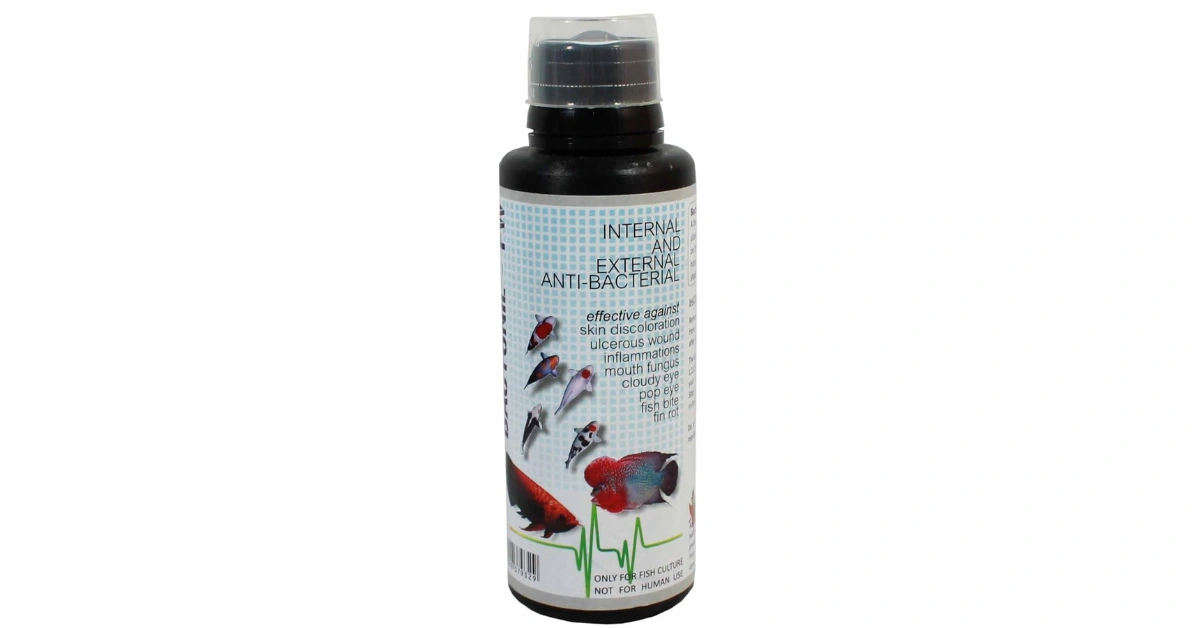
This product is formulated to help control and prevent common bacterial infections in freshwater fish. Maintaining disease-free fish contributes to the overall health and cleanliness of the aquarium by reducing biological waste from ailments.
- Approximate Price: ₹120 - ₹250 (for 60ml - 120ml).
3. Life Aayu Water Conditioner & Chlorine Remover
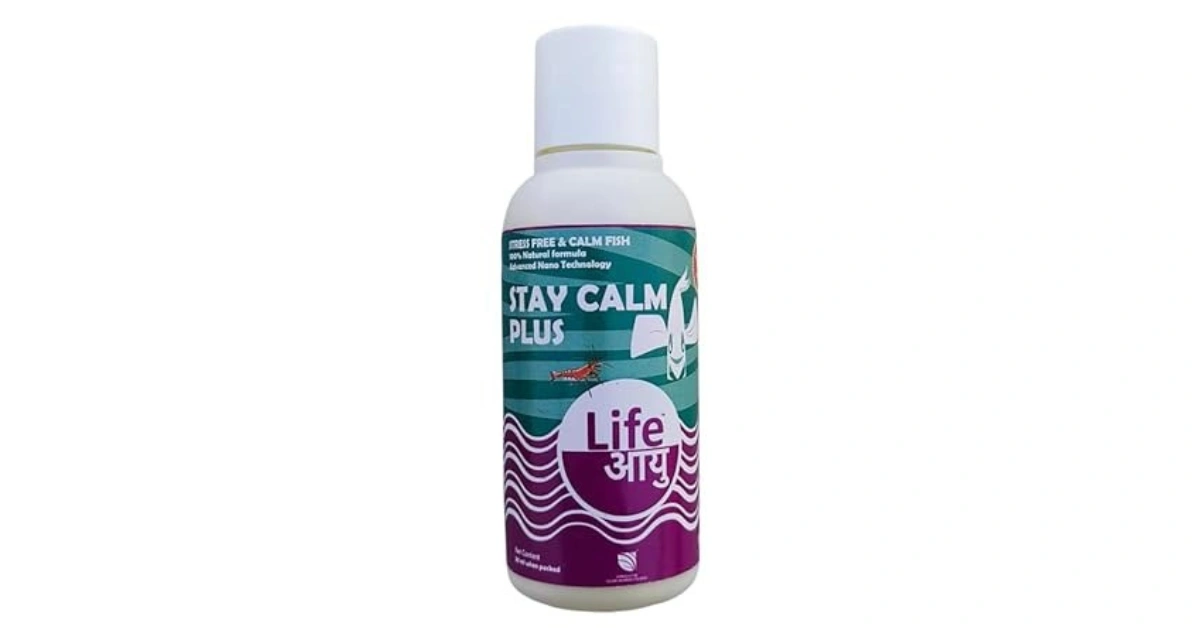
This brand is known for its focus on natural ingredients. It offers a water conditioner formulated to make tap water safe. It removes chlorine, chloramine, and other harmful substances, often incorporating beneficial herbal components.
- Approximate Price: ₹200 - ₹400 (for 100ml - 250ml).
4. AquaNature Chlorine ERASE Advance (Water Conditioner)
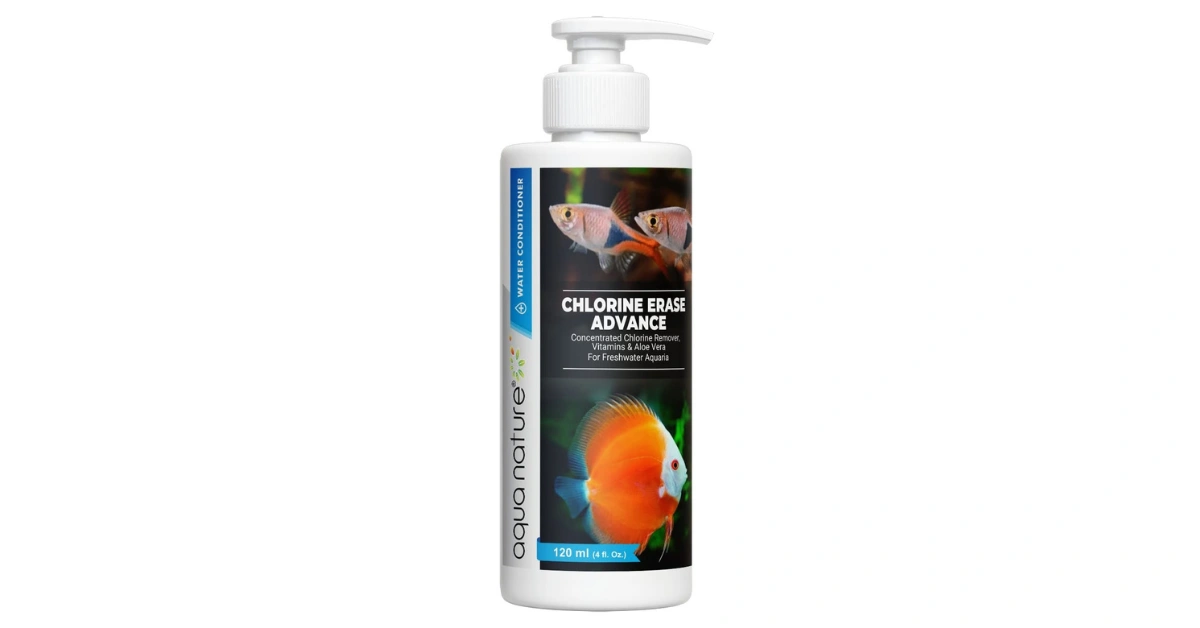
This water conditioner is specifically designed to neutralise chlorine and chloramines from tap water quickly. It often includes added benefits like slime coat protection for fish, vital during water changes and for overall fish health.
- Approximate Price: ₹200 - ₹350 (for 120ml - 250ml).
5. OZPOLISH Bio-Cure (Beneficial Bacteria & Sludge Remover)
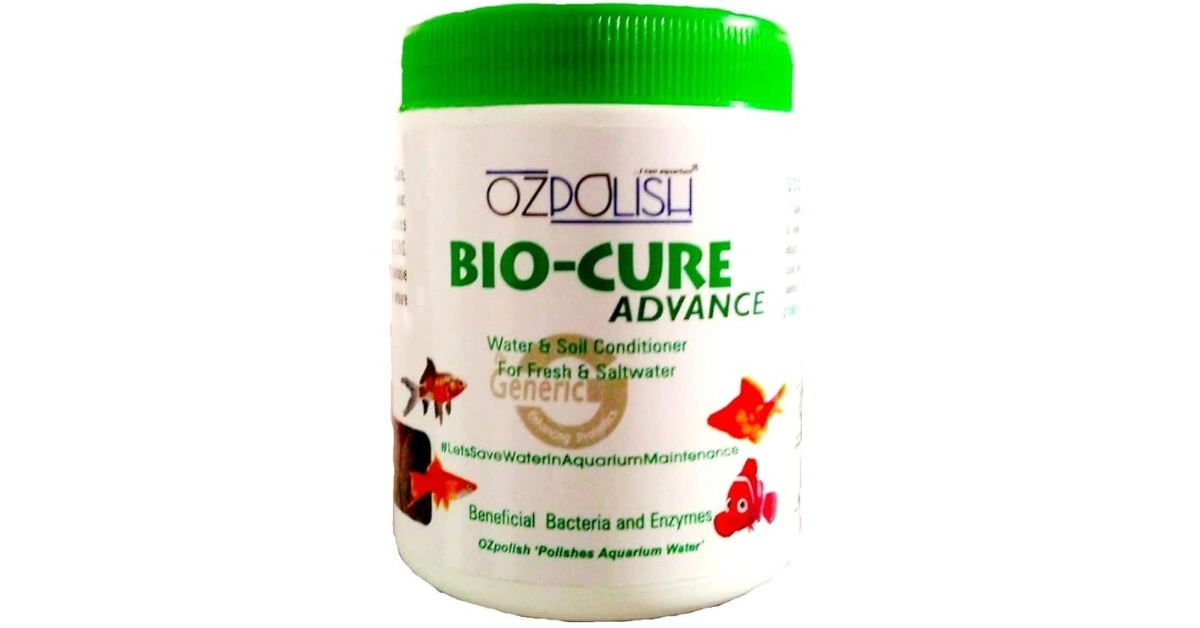
This product contains a consortium of beneficial bacteria. These microorganisms aid in breaking down fish waste, uneaten food, and organic sludge, while also helping to control ammonia levels, thus naturally contributing to a cleaner aquarium.
- Approximate Price: ₹350 - ₹500 (for 50g-100g powder).
How NoBroker Can Help with Cleaning Services?
Maintaining your aquarium is a detailed task. If household chores consume your time, NoBroker's professional home cleaning services across India can assist. They manage your home's cleanliness, freeing you to focus on specialised jobs like how to clean a fish tank, ensuring both a spotless house and a healthy aquatic environment for your pets.
Frequently Asked Questions
Ans. Generally, perform a 20-30% partial water change and gravel vacuum every 1-2 weeks. The exact frequency depends on tank size, fish load, and filtration.
Ans. Yes, but you must first treat it with a water conditioner (dechlorinator) to remove chlorine and chloramine, which are harmful to fish and beneficial bacteria.
Ans. It's generally better to leave fish in the tank during routine cleaning, as moving them can cause stress. Only remove them if they are making a major escape or if necessary.
Ans. Common reasons include overfeeding, overstocking (too many fish), insufficient filtration, insufficient water changes, or excessive light (leading to algae).
Ans. Yes, plain white vinegar is safe for cleaning empty tanks or tank decorations (rinse extremely well afterwards). To clean the inside glass of an occupied tank, only use it above the waterline and prevent any from dripping in. Never use soap or detergents.
Recommended Reading

List of the Best Home Cleaning Apps: Book Home Cleaning Services for Daily and Deep Cleaning
January 31, 2025
21306+ views

Diwali Cleaning Tips and Guide: Make Your Home Shine for the Festival in 2025
January 31, 2025
17824+ views

Top 10 Best Robot Vacuum Cleaner in India 2025: Feature, Price and Performance
January 31, 2025
13150+ views

How to Keep Your Home Dust-Free: Best Cleaning Tips & Tricks in 2025
November 28, 2023
9940+ views

Top 30 Cleaning Tools You Need for a Spotless and Well-Maintained Home in 2025
January 31, 2025
8753+ views
Loved what you read? Share it with others!
NoBroker Easy Cleaning Tips Testimonials
Awesome 👍
Nice
Nice
Nice👍
Good
Amazing
Best home cleaning services provider
“Great experience! The NoBroker home cleaning team was punctual, professional, and made my house look fresh and spotless. Worth the money!”
Perfect
Best
Good
Woww amazing work
Amazing
No broker home cleaning was smooth and hair with friendly staff and excellent cleaning quality
Excellent work and best service 😊
"NoBroker home cleaning did a fantastic job—reliable service and my home feels fresh and new."
Staff was polite and cleaning quality was impressive. Recommended.”
"NoBroker home cleaning delivered great value for money with punctual staff and impressive results."
Staff was polite and cleaning quality was impressive. Recommended.”
I m hired Nobroker home cleaning and they work perfectly. Definitely try this
Timely, clean, and hassle-free service. Happy with the work!”
NoBroker home cleaning services one off the best service.
Good work
Good services + good team
Excellent work 💯👏
Nice work 😍
Ossum work 🥰
Nice work 💞
Very good experience
Excellent
Suparr
Good
Awesome
Good service providers. I guess they are best in my view.
My goods were delivered on time, as promised, with careful handling.
NoBroker Movers made my relocation stress-free and seamless.
The service was reliable, with attention to detail and a commitment to quality.
My goods were delivered on time, as promised, with careful handling.
NoBroker Movers provided a smooth and stress-free relocation experience.
Most Viewed Articles

List of the Best Home Cleaning Apps: Book Home Cleaning Services for Daily and Deep Cleaning
January 31, 2025
21306+ views
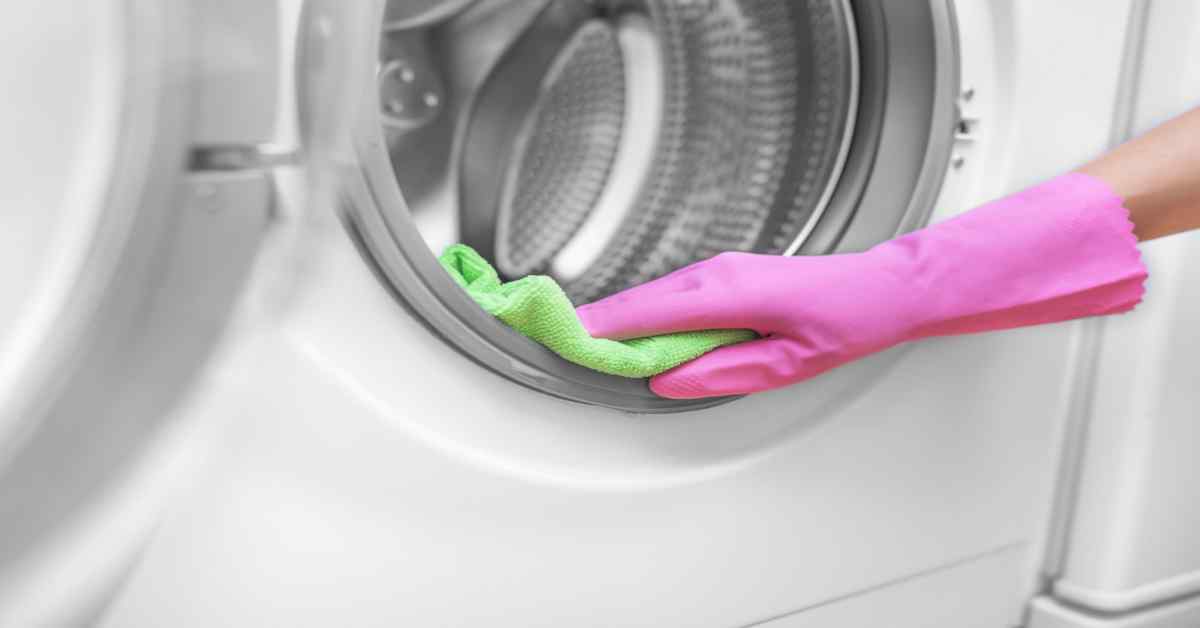
Deep Clean Your Washing Machine: Step-by-Step Guide & Tips
January 31, 2025
18486+ views

Diwali Cleaning Tips and Guide: Make Your Home Shine for the Festival in 2025
January 31, 2025
17824+ views
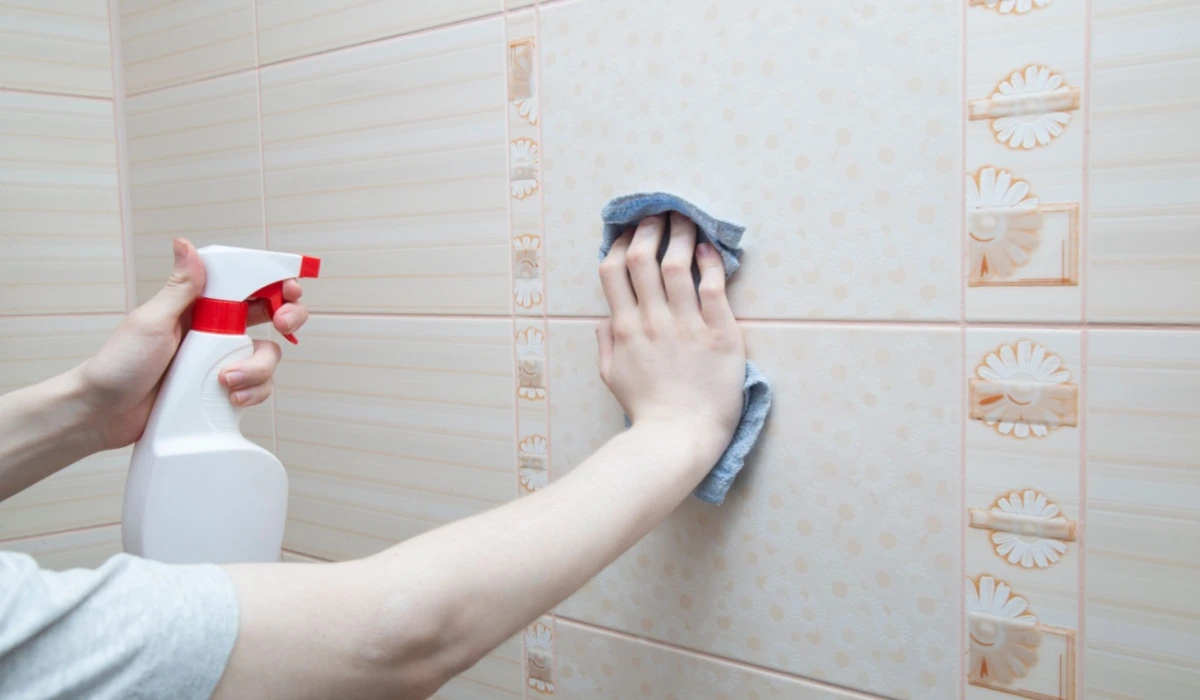
How to Clean Bathroom Tiles: Easy and Effective Methods to Remove Stains and Grout
January 15, 2025
15862+ views
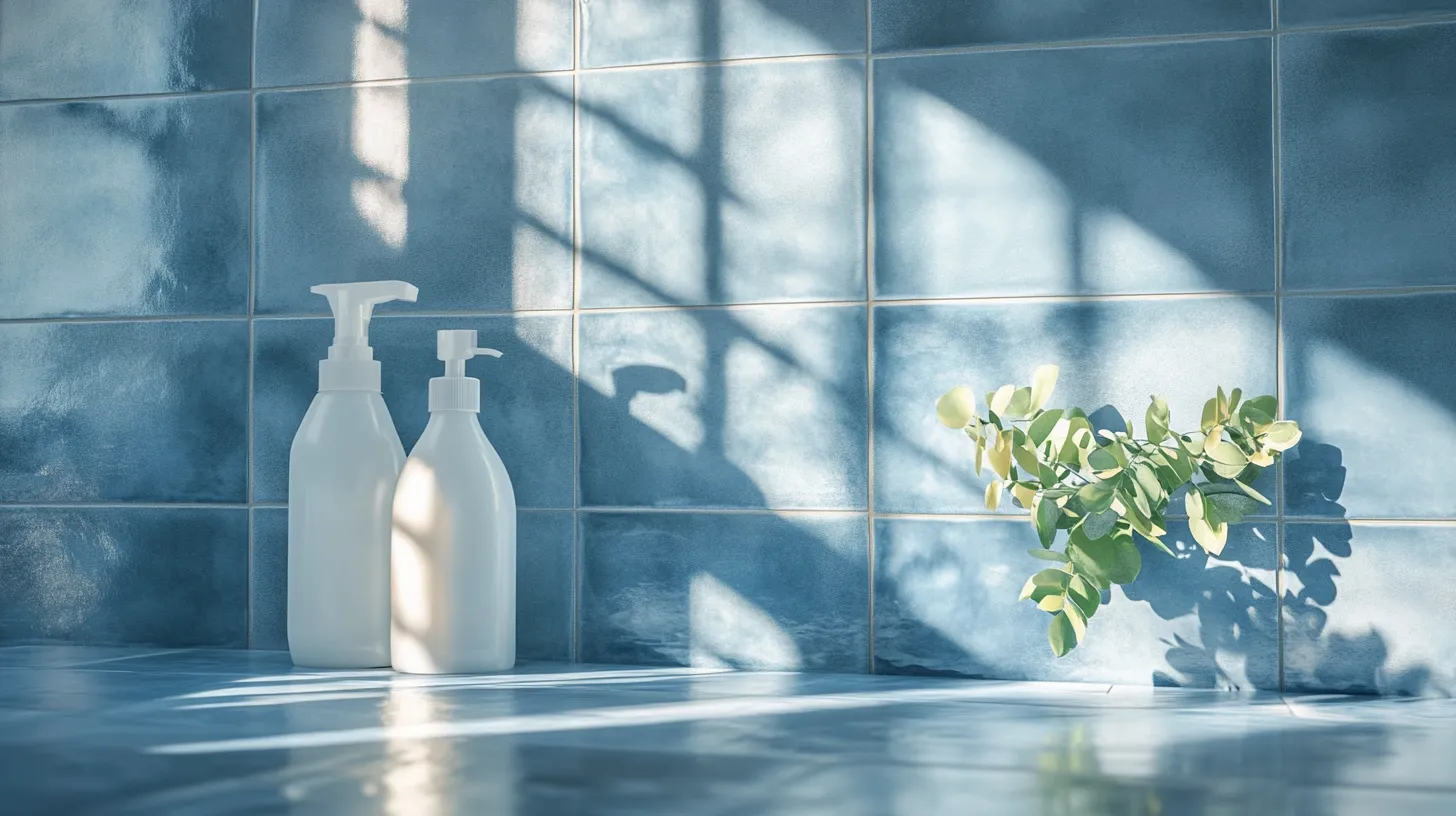
Top 10 Tile Cleaner Liquids with Prices in India for 2025
February 23, 2025
14138+ views
Recent blogs in
How to Clean Wall Wallpaper at Home Without Damage: Easy DIY Cleaning Tips
November 24, 2025 by Priyanka Saha
Most 10 Common Cleaning Mistakes and How to Fix Them for a Truly Spotless Home
November 21, 2025 by Ananth
Zero-Waste Cleaning Routine for Indian Homes: Simple, Natural & Sustainable Home Care
November 21, 2025 by Vivek Mishra







Join the conversation!